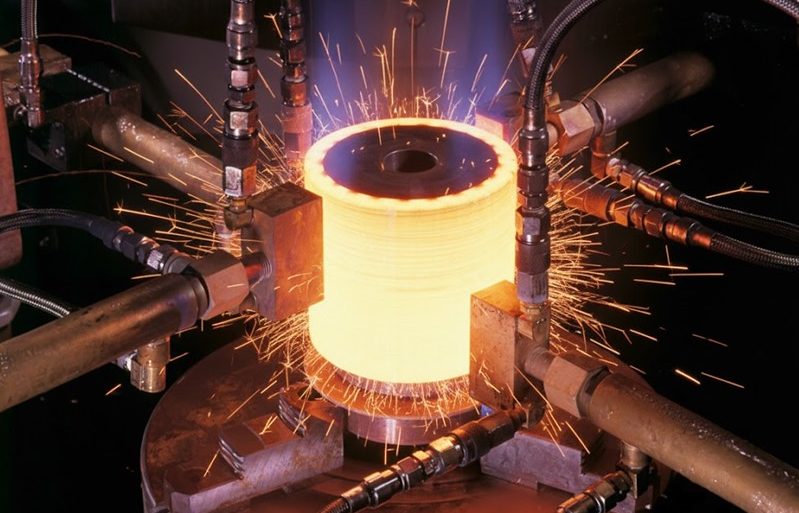
Smart and Optimum Hardening Solutions
Induction Hardening: Heat treatment process plays a vital role in which metal parts with sufficient carbon content are rapidly heated to a high temperature by electromagnetic induction and immediately cooled. It is usually used for various steel and steel alloys to increase mechanical properties in a specific area, such as surface hardness, fatigue strength, and wear resistance. Compared to traditional heat-treating methods, induction hardening remains an effective way to produce hardened surfaces on parts quickly and accurately.
Induction Hardening can be employed at the required stage of part process over other fixed stage processes.
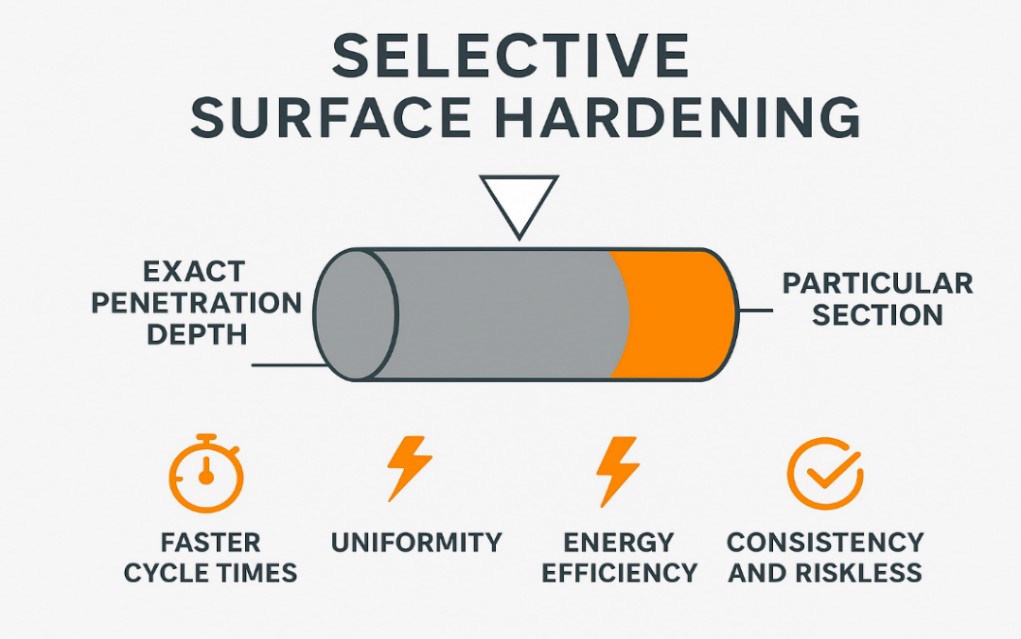
Induction Hardening Techniques
- Single-Shot Hardening: The entire surface is heated and quenched in one go. Ideal for simple, symmetrical parts like gears.
- Progressive (Scan) Hardening: The component moves through the coil, or the coil moves along the part. Commonly used for shafts and axles.
- Spin Hardening: The part is rotated within the coil, making it suitable for rings or cylindrical components requiring uniform surface treatment.
- Dual Frequency Hardening: Uses two frequencies simultaneously to heat both the surface and slightly deeper layers, ensuring a more gradual hardness transition.
Choosing the Right Hardening Technique for Your Component
| Method | Process | Applications |
|---|---|---|
| Induction Hardening | Surface heat treatment with electromagnetic field to rapidly heat specific areas of a metal part and quenching. Surface hardens keeping the core ductile. | Shafts, gears, camshafts, axles, spindles, rollers, couplings — used in automotive, industrial, and heavy machinery. |
| Flame Hardening | Heating the surface of a part with a high-temperature flame and quenching it to form a hard outer layer. | Large gears, crankshafts, rails, machine ways, and heavy construction equipment parts. |
| Laser Hardening | Uses a concentrated laser beam to heat and self-quench the metal surface, improving hardness and wear resistance. | Precision parts, dies, cutting tools, molds, and aerospace components requiring fine surface control. |
| Electron Beam Hardening | Electron beam in a vacuum to heat and self-quench a thin metal surface for enhanced hardness. | Aerospace and defence components, turbine blades, and high-value precision parts. |
| Carburization (Case Hardening) | The component is heated in a carbon-rich atmosphere, allowing carbon to diffuse into the surface to create a hard outer layer. | Gears, bearings, camshafts, and components requiring deep case depth and wear resistance. |
| Nitriding | Nitrogen is diffused into the surface of steel to enhance hardness, fatigue strength, and corrosion resistance without quenching. | Crankshafts, valves, dies, extrusion screws, and engine parts exposed to heat and wear. |
Induction hardening is ahead for its speed, precision, and repeatability. Processes like flame hardening and laser hardening are often considered its closest equivalents in terms of surface hardening with thermal analysis relevance.
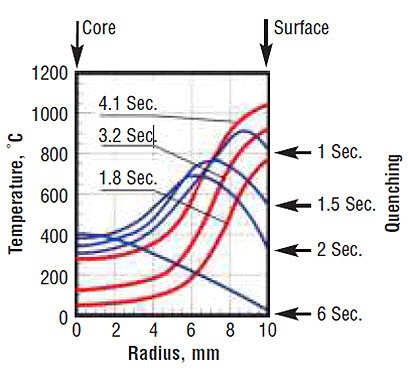
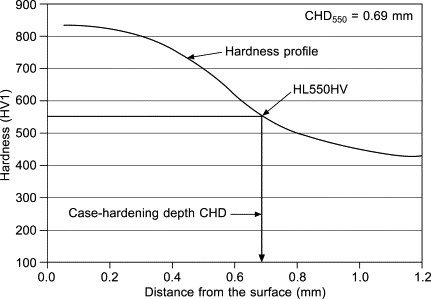
Thermal Analysis for Induction Hardening and Others
How Bombay Metrics Tackles Challenges in Induction Hardening
Achieving Precise Case Depth and Hardness for Complex Geometries: We utilize advanced, automated induction hardening machines with sophisticated power control. Our metallurgists and engineers program these machines to deliver precise amounts of energy to the workpiece for the exact duration required.
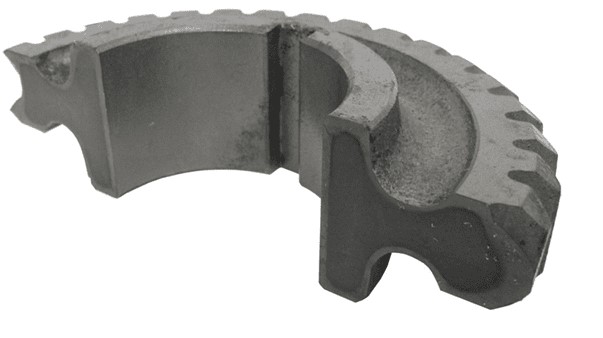
We conduct a detailed metallurgical analysis of each part to determine the optimal frequency, power, and coil design, ensuring a uniform and consistent hardened layer every time.

Battling Distortion and Warping: We employ a combination of process control and innovative tooling to minimize distortion. Our engineers design custom fixtures and jigs to hold the parts securely during the process.
We use controlled quenching methods and specialized media to manage the cooling rate, which helps mitigate internal stresses and prevent unwanted warping. For parts that are highly susceptible to distortion, we may incorporate pre-process stress-relieving treatments.
Mitigating the Risk of Cracking: Our process begins with a meticulous analysis and selection of material at the initial stage. Suitable corroboration among the stakeholders ensures the base material is appropriate for induction hardening.
The quenching process involves selecting the ideal medium (e.g., polymer solution, water, or oil) and flow rate to cool the part effectively without creating excessive stress.
Managing Equipment Investment: For smaller operations, we suggest considering cloud-based simulation platforms to test and refine induction strategies before investing in physical equipment—reducing trial-and-error and capital risk.
Selective Hardening: Very few heat treatment processes can achieve selective hardening with no masking required. Any areas of post-welding or post-machining on a metal component will stay soft after induction hardening.
Works with Low-Cost Steels: Low-cost steels are ideal for induction hardening. This readily machinable, low-cost material responds well to induction heating with minimal risk of cracking.
Flexibility: Metal parts can easily be tempered after induction hardening, allowing flexibility to adjust hardness levels as desired. Since the heat treatment results in a martensitic structure, the metal can be tempered to reduce hardness without causing brittleness.
Bombay Metrics’ Proficiencies in Induction Hardening
At Bombay Metrics, we bring in state-of-the-art equipment and expert engineering practices to ensure optimum results in every induction hardening project.
- Customized Process Design: We tailor heating cycles and quenching methods based on product requirements.
- Quality Assurance: Advanced inspection techniques like hardness testing, microstructural analysis, and dimensional verification.
- Industry-Specific Applications: We deliver hardened parts that meet stringent global standards—from automotive shafts and cam components to heavy-duty gears.
- Sustainability: By using precise, energy-efficient induction systems, we support greener manufacturing practices.
“At Bombay Metrics, we combine advanced technology with deep engineering knowledge to deliver reliable induction hardening solutions that meet the unique needs of our customers. By focusing on quality, efficiency, and long-term performance, we ensure that every part we produce is built to withstand demanding applications while offering maximum value to our clients.”

